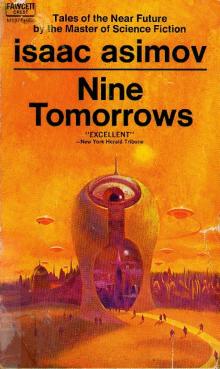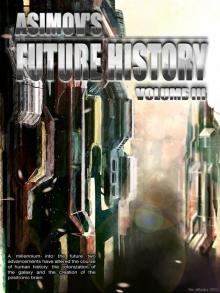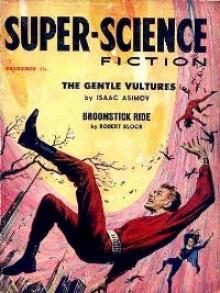- Home
- Isaac Asimov
Asimov's Future History Volume 2
Asimov's Future History Volume 2 Read online
Asimov’s Future History
Volume II
All stories copyright Isaac Asimov and the Estate of Isaac Asimov, unless otherwise noted below.
All other stories copyright by the respective authors listed below.
Predator - By William F. Wu. First published as Isaac Asimov's Robots in Time: Predator, April 1993
Marauder- By William F. Wu. First published as Isaac Asimov's Robots in Time: Marauder, July 1993
Warrior- By William F. Wu. First published as Isaac Asimov's Robots in Time: Warrior, October 1993
Dictator- By William F. Wu. First published as Isaac Asimov's Robots in Time: Dictator, February 1994
This ePub edition v1.0 by Dead^Man March, 2011
Layout and design by DeadMan
Cover art “Corridor city” by Astrokevin of DeviantArt
Future History inlay “Summer days” by Talros of DeviantArt
Cover design by Dead^Man
Chronology of events in Isaac Asimov’s positronic robot and Foundation stories, compiled by Johnny Pez
Table of Contents
Copyright
2140 AD Predator
2140 AD Marauder
2140 AD Warrior
2140 AD Dictator
Sources of dates
Predator
2140 A.D.
1
MOJAVE CENTER GOVERNOR sat in his office, deep in the underground city of Mojave Center. He was an experimental humaniform robot of a type that was new this year, 2140. Each of the Governor robots was currently running all the municipal systems of one entire, newly-constructed city. They were doing so under probationary status, monitored by a committee of scientists through their computer.
His office was in the middle level of the city, in the center of that level. He didn’t really need an office at all since most of his work was done through his radio link to the city computer or directly to municipal departments; further, he could plug into various terminals when necessary. However, he had learned that humans sometimes preferred doing business in an office, so he maintained a small room in Mojave Center for that purpose.
At the moment, MC Governor was alone. He plugged his humaniform forefinger into a wall jack. Inside the jack, the end of his finger opened and plugged into the system. He contacted the city computer.
“I am going to run a simulation program again,” said MC Governor. “I will continue my normal duties through my multi-tasking system. However, I instruct you not to transfer any communication or other interruption lower than Priority 5. When I have finished running the simulation, I will notify you.”
“Acknowledged,” said the city computer.
MC Governor returned his finger to human shape, breaking the shielded connection. For the sake of security, he told himself, he chose not to use radio communication concerning the simulation programs. Lately he had been running them more often than before.
He ran down his list of programs. They were standard simulation programs that all the Governors used to discover and correct potential problems and challenges without actually having to face them in real life. His favorites involved some sort of disaster that befell Mojave Center, requiring him to respond urgently under the Laws of Robotics to restore the situation to normal. Like all positronic robots, he was programmed so that his greatest imperative, and his greatest reward, was in obeying the Laws. The First Law of Robotics was, “A robot may not injure a human being, or, through inaction, allow a human being to come to harm.”
This time, he selected the program called Desert Flash Flood. It was essentially a form of role-playing game. He began running it. Suddenly he found himself standing in the main thoroughfare of Mojave Center, Antelope Valley Boulevard, with water a meter high pouring down the street.
MC Governor was a very tall, brawny robot. He ran through the water to a young woman who was stumbling and splashing helplessly, trying to hold a toddler in her arms. As MC Governor picked her up and strode through the current toward an escalator, he radioed the city monitors who controlled all the basic life functions.
“Shut down all electricity to nonessential services if they have failed to shut down automatically,” he instructed the computer, as he carried the woman and her child. “Run a status check on the emergency electrical systems providing essential services.”
Right now, his greatest worry was the electrocution of humans if broken power lines touched the flood water. As a Governor robot, he was a central control unit, capable of managing entire cities, from traffic to essential services and utilities, to environmental control and industry. The city had its own decentralized computer systems, which reported directly to him and took his instructions by way of his internal radio and video systems.
“Thank you,” the woman gasped, clutching her drenched toddler as MC Governor set her down on the rising escalator.
Almost immediately, the monitors reported that nonessential services were being discontinued. The escalator stopped moving, but the woman stumbled on up the steps. MC Governor waded back into the water toward a trolley full of humans stranded on one side of the boulevard. They were yelling and screaming in panic. Its robot driver was speaking calmly to his passengers, asking for patience.
The city monitors reported that the emergency power system was functioning safely.
“Send me all data related to the cause of the flood,” he ordered. At the same time, he moved behind the stranded vehicle. It normally ran on a battery-powered electric motor. Now the robot driver steered as MC Governor pushed the vehicle to the stationary escalator, where the driver began helping the humans onto it.
As the monitors all over the city reported their data, MC Governor computed the information. A flash flood had taken place in the Mojave Desert above them, washing down from the San Gabriel Mountains to the south. Normally, it should not have been a problem. The top surface of Mojave Center, a large rectangle on the desert floor, was comprised mostly of solar cells, which provided power. It was fully sealed, of course, so that flood water would normally pass right over the underground city. In this case, however, the force of the flood had ripped open the surface and water was still pouring down into the top levels of the city.
Robots working on those levels were already struggling to seal off the leak. Others all over the city were coordinating evacuation efforts for the humans. MC Governor was about to request the details of those efforts when he was interrupted from outside the simulation program.
“City computer calling Mojave Center Governor with a Priority 8 emergency.”
MC Governor shut off the simulation and inserted his finger into the wall jack again to shield his communication. “MC Governor here. Report the emergency.”
“Flooding is reported on the main level over Antelope Valley Boulevard. At this time, the Priority 8 emergency is estimated to be thirty-seven minutes from reaching a Priority 9 level without additional measures.”
“What is the cause of the flooding?”
“The circulation of water was routed incorrectly through the city. Too much water was directed to the problem area, and the increased pressure burst two main valves simultaneously.”
“Why was the water routed incorrectly?”
“The orders came from you.”
“Are all standard emergency procedures under way?”
“Affirmative. The most critical is that all drainage systems are open to the maximum.”
MC Governor quickly broke the connection and ran outside. The scene was similar to that of the simulation, though not identical. Not as much water was running down the boulevard; it was only half a meter deep, but many more people were running for the escalators and sliding ramps, yelling to each other
. MC Governor was horrified; somehow, he had allowed his involvement with the simulation to influence his multi-tasking ability. Unwittingly, he had begun to create the flood in the simulation, putting humans at risk in violation of the First Law of Robotics.
He waded into the water, snatched up two children who had been knocked off their feet by the current, and carried them to the nearest rising slide ramp.
“City computer,” he radioed. “What is the status of the broken valves now?”
“A robot maintenance team has shut off the water flow manually at the preceding valves. The broken valves are not yet under replacement.”
Around MC Governor, people were still in danger. The shallow water would not drown anyone in the areas where it had flowed into gentle backwaters, but the current was powerful enough to knock people down. If they were injured, they might drown even in shallow water. Other robots were already wading through the water, carrying people to safety.
A short, balding man with frizzy gray hair had lost his footing. Though sitting in water that was not over his head, he was clinging to the bumper of a small utility vehicle, unable to pull himself up against the force of the current. He pulled himself toward the bumper, tried to gain traction with his feet, and was knocked down again. This time he lost his grip and was rolled roughly down the boulevard.
MC Governor waded quickly to the man and lifted him up. He was an engineer named Max Eisen, to whom MC Governor had spoken briefly before. As MC Governor carried him, Eisen coughed and wheezed, but was breathing. In several long strides, MC Governor returned to the ramp, where he set the man down in a sitting position. Then he looked around again.
“Over there,” Max wheezed, pointing.
A young woman with curly orange hair had jumped up onto the pedestal next to an abstract stone sculpture. She was looking doubtfully at the water swirling around the base of the pedestal. As MC Governor hurried toward her, the pedestal tilted from the imbalance her weight caused. Water flowed under its raised edge, pushing it over.
The young woman gasped as she was thrown through the air. The stone sculpture began to slide off its pedestal in the same direction. Before she hit the water, however, MC Governor managed to catch her and swing her out of the way. In the spot where she would have struck the water, the stone sculpture splashed and then cracked against the hard floor beneath it.
“You are safe now,” said MC Governor, carrying her back to the ramp to join Max.
The water was slowing down quickly now. With the broken pipes turned off and the drainage open to the maximum, the emergency was passing. Up and down the boulevard, robots were helping humans to safety and seeing to their injuries if they had sustained any.
“Elaine,” said Max. “I would like to introduce you to Mojave Center Governor, the robot who runs our city.”
“Pleased to meet you.” Elaine smiled gratefully, brushing her orange hair out of her face. “And thank you.”
“I may not deserve thanks,” MC Governor said grimly. “I should never have allowed this to happen.”
Internally, he radioed the water system monitors again. They all reported good drainage. Then he called the city computer. “Are you aware of any immediate First Law imperatives that are not being addressed?”
“No.”
“Compile total damage estimates, including human casualties, and relay them to me as soon as they are reasonably complete. Prioritize repairs according to safety factors.” He was very worried that his lapse had caused humans to be injured or worse.
“Acknowledged,” said the city computer.
Then MC Governor reviewed the power monitors and turned the electricity back on in all the branches of the system that were undamaged.
“Elaine just moved here,” said Max. “I’m afraid this wasn’t a very good introduction, Elaine, but Mojave Center really promises to be a good place to live.”
MC Governor towered over Max as he looked down at him. “Do you need medical care? Either of you?”
“I’m okay,” said Elaine, looking up at him with wide-eyed wonder. “Thanks to you and the First Law of Robotics.”
“I twisted my ankle,” said Max, shifting his weight. “I don’t think it’s too serious, but maybe it should be looked at.”
“Of course.”
“We shouldn’t keep you,” said Elaine. “I’m sure you should be in contact with all your subordinates.”
“I am,” said MC Governor. “My multi-tasking ability allows me to make contacts and decisions even as we speak.” He lifted Max gently and began walking up the ramp. “Max, I will take you to the nearest first aid station.”
“Okay.”
Elaine walked with them. “Can I ask you another question? Why are you so gigantic?”
Max laughed.
“Actually, I am a gestalt robot. I am comprised of six robots, both in body and in mind.”
“What?” She cocked her head to one side, puzzled. “You mean you can divide into six smaller robots?”
“Yes, that is right.” MC Governor smiled. “The reason I am this big is that I can divide into six robots of rather small human stature, slender and short.”
“But what for? Why not just make one big one, like you are, if that’s what the city needs?”
“In the event of certain types of large-scale emergencies, I can divide into my component robots so that each can move directly to a different site to manage damage control.”
“Makes sense to me,” said Max. “Right, Elaine?”
“Yes, I see. But what about your brain, Governor? Does it segment somehow?”
“No, not physically.” MC Governor was amused at the thought. “Their positronic brains are physically distinct from mine, of course, but right now all six are merging data with mine to create my own personality. In order to divide, I will have to allow each latent personality to separate and take control over its data as well as its own body.”
“I’m impressed,” said Elaine. “And a little confused. I never heard of anything like this — that is, a robot like you.”
“He represents the new cutting edge in municipal robotics,” said Max. “I read all about him. And this very moment, even as he speaks to us, he’s also monitoring all the energy consumption, security matters, engineering functions, and anything else you can think of regarding the city.”
“You’re doing all that right now?” Elaine studied MC Governor’s face, as though for a clue of some sort to the effort he was expending.
“That is the job.” MC Governor shrugged amiably. “I was constructed for it, so to me, combining all these duties is not surprising.”
“Tell me,” said Elaine, studying his face curiously. “What do you do for fun?”
“Aw, I don’t think robots have a lot of fun,” said Max. “Oh, do they?”
“As a robot, my greatest pleasure is in obeying the Three Laws of Robotics. That value is hardwired into my positronic brain, as it is with all positronic robots.” MC Governor smiled, enjoying the mere thought of them. “The First Law of Robotics says,, A robot may not injure a human being —’”
“Yes,” said Elaine, nodding recognition. “We learned them in school.”
MC Governor heard her, but he really wanted to recite them all. Doing so gave him a feeling of security and satisfaction. “The Second Law is, ‘A robot must obey the orders given it by human beings except where such orders would conflict with the First Law.’ Then the Third Law of Robotics is —”
“‘A robot must protect his own existence as long as such protection does not conflict with the First or Second Laws,’ “Elaine finished, grinning impishly.
“Yes — exactly,” said MC Governor, suddenly embarrassed. “Please pardon me for boring you with this matter.” He was about to ask Elaine some polite questions about her interests when he received a radio alert from the city’s communication center.
“Governor, Priority 6 communication is requested.”
“Acknowledged,” said MC Governor. Priority 6
also required a shielded communication, so he would have to take it in his office, but it was not enough to override his duty to Max. He delivered Max to the robots at a first aid station, bade both humans goodbye, and hurried toward his office.
As MC Governor strode quickly down Antelope Valley Boulevard toward one of the slidewalks, he judged the damage he could see. The underground city had different levels, connected by various moving ramps, slidewalks, and lifts; generally, they appeared untouched. Of course, much of the water damage would not be immediately visible.
As he walked, all he could think about was that he had failed in his duty.
MC Governor sat down in his desk chair and plugged his humaniform forefinger into a wall jack once more. He gave his password and called for the Priority 6 message.
“Message source: The Governor Robot Oversight Committee Computer.
“Text: The Governor Robots of the following experimental cities have entered closed loops: Emerald City, Republic of Ireland; Kenyatta Center, Kenya; New Monegaw Springs, Missouri; Osaka Center, Japan; Rio de Oro Center, Brazil.”
The exact times that each Governor had entered the closed’ loop were given next. MC Governor adjusted those times for the different time zones in which each city was located around the world. He found that each Governor robot had malfunctioned within the last three hours.
MC Governor disconnected, his mind working quickly. He was one of only six Governor robots being tested on Earth right now, and the other five had all failed today. Since the Governors had all been constructed with the same basic design, he was forced to conclude that he would experience the same fate, probably very soon.
MC Governor had a very levelheaded, rational, not very flashy personality. He was totally dedicated to his job. However, when he was thinking alone, without having to pace himself to human abilities or to slower electronic equipment, he could think extremely quickly.
Now his own existence was threatened. Since neither a threat to humans nor direct human orders were present, the First and Second Laws of Robotics did not apply. Under these conditions, the Third Law of Robotics compelled him to evaluate his position at maximum efficiency in both speed and clarity.

 The Return of the Black Widowers
The Return of the Black Widowers The Stars, Like Dust
The Stars, Like Dust Foundation
Foundation David Starr Space Ranger
David Starr Space Ranger I, Robot
I, Robot Puzzles of the Black Widowers
Puzzles of the Black Widowers Casebook of the Black Widowers
Casebook of the Black Widowers The Ugly Little Boy
The Ugly Little Boy Azazel
Azazel Pebble in the Sky
Pebble in the Sky Foundation and Empire
Foundation and Empire The Complete Robot
The Complete Robot Fantastic Voyage
Fantastic Voyage Foundation and Earth
Foundation and Earth The Naked Sun
The Naked Sun The Currents of Space
The Currents of Space Foundation's Edge
Foundation's Edge The Robots of Dawn
The Robots of Dawn Nightfall
Nightfall The Caves of Steel
The Caves of Steel Prelude to Foundation
Prelude to Foundation Nemesis
Nemesis Robot Dreams
Robot Dreams More Tales of the Black Widowers
More Tales of the Black Widowers The Complete Stories
The Complete Stories Robot Visions
Robot Visions Lucky Starr And The Moons of Jupiter
Lucky Starr And The Moons of Jupiter Lucky Starr and the Big Sun of Mercury
Lucky Starr and the Big Sun of Mercury The End of Eternity
The End of Eternity The Bicentennial Man and Other Stories
The Bicentennial Man and Other Stories Lucky Starr And The Rings Of Saturn
Lucky Starr And The Rings Of Saturn Buy Jupiter and Other Stories
Buy Jupiter and Other Stories Forward the Foundation
Forward the Foundation Lucky Starr and the Oceans of Venus
Lucky Starr and the Oceans of Venus The Positronic Man
The Positronic Man The Portable Star
The Portable Star Asimovs Mysteries
Asimovs Mysteries Earth Is Room Enough
Earth Is Room Enough The Gods Themselves
The Gods Themselves Youth
Youth The Early Asimov Volume 3
The Early Asimov Volume 3 The Winds of Change and Other Stories
The Winds of Change and Other Stories Of Time, Space, and Other Things
Of Time, Space, and Other Things Nine Tomorrows
Nine Tomorrows Time Warps
Time Warps Robots and Empire
Robots and Empire Young Star Travelers
Young Star Travelers Fantastic Voyage II: Destination Brain
Fantastic Voyage II: Destination Brain Second Foundation
Second Foundation The Rest of the Robots
The Rest of the Robots NINE TOMORROWS Tales of the Near Future
NINE TOMORROWS Tales of the Near Future Daneel Olivaw 1 - The Caves of Steel
Daneel Olivaw 1 - The Caves of Steel THE BICENTENNIAL MAN
THE BICENTENNIAL MAN David Starr Space Ranger (lucky starr)
David Starr Space Ranger (lucky starr) David Starr Space Ranger (ls)
David Starr Space Ranger (ls) Lucky Starr And The Big Sun Of Mercury ls-4
Lucky Starr And The Big Sun Of Mercury ls-4 Pebble In The Sky te-1
Pebble In The Sky te-1 Asimov’s Future History Volume 9
Asimov’s Future History Volume 9 Gold: The Final Science Fiction Collection
Gold: The Final Science Fiction Collection Foundation and Earth f-7
Foundation and Earth f-7 Asimov's New Guide to Science
Asimov's New Guide to Science STORM OVER WARLOCK
STORM OVER WARLOCK Stars, Like Dust
Stars, Like Dust Norby The Mixed-Up Robot
Norby The Mixed-Up Robot Found!
Found! Asimov’s Future History Volume 11
Asimov’s Future History Volume 11 Second Foundation f-5
Second Foundation f-5 Asimov’s Future History Volume 15
Asimov’s Future History Volume 15 The Early Asimov. Volume 1
The Early Asimov. Volume 1 Secound Foundation
Secound Foundation Daneel Olivaw 3 - The Robots of Dawn
Daneel Olivaw 3 - The Robots of Dawn Asimov’s Future History Volume 6
Asimov’s Future History Volume 6 The Early Asimov. Volume 2
The Early Asimov. Volume 2 Lucky Starr And The Rings Of Saturn ls-6
Lucky Starr And The Rings Of Saturn ls-6 100 Malicious Little Mysteries
100 Malicious Little Mysteries Forward the Foundation f-2
Forward the Foundation f-2 I.Asimov: A Memoir
I.Asimov: A Memoir Foundation's Edge f-6
Foundation's Edge f-6 Lucky Starr and the Pirates of the Asteroids ls-2
Lucky Starr and the Pirates of the Asteroids ls-2 Robot City 1 & 2
Robot City 1 & 2 The Fourth Science Fiction Megapack
The Fourth Science Fiction Megapack Asimov’s Future History Volume 16
Asimov’s Future History Volume 16 The Dim Rumble
The Dim Rumble Asimov's Future History Volume 3
Asimov's Future History Volume 3 The Currents Of Space te-3
The Currents Of Space te-3 Asimov’s Guide To Shakespear. Volume 1
Asimov’s Guide To Shakespear. Volume 1 Asimov’s Future History Volume 13
Asimov’s Future History Volume 13 Asimov’s Future History Volume 12
Asimov’s Future History Volume 12 The Secret Sense
The Secret Sense Of Time and Space and Other Things
Of Time and Space and Other Things Norby tnc-2
Norby tnc-2 Norby The Mixed-Up Robot tnc-1
Norby The Mixed-Up Robot tnc-1 Misbegotten Missionary
Misbegotten Missionary Asimov’s Future History Volume 19
Asimov’s Future History Volume 19 Fantastic Voyage II: Destination Brain fv-2
Fantastic Voyage II: Destination Brain fv-2 Asimov’s Future History Volume 10
Asimov’s Future History Volume 10 Asimov's Future History Volume 2
Asimov's Future History Volume 2 Feeling of Power
Feeling of Power In the Beginning
In the Beginning The Caves of Steel trs-1
The Caves of Steel trs-1 Asimov's Future History Vol 2
Asimov's Future History Vol 2 Caliban c-1
Caliban c-1 The Gentle Vultures
The Gentle Vultures Utopia c-3
Utopia c-3 Prelude to Foundation f-1
Prelude to Foundation f-1 Short Stories Vol.1
Short Stories Vol.1 Asimov’s Future History Volume 8
Asimov’s Future History Volume 8 Daneel Olivaw 4 - Robots and Empire
Daneel Olivaw 4 - Robots and Empire Lucky Starr The And The Moons of Jupiter ls-5
Lucky Starr The And The Moons of Jupiter ls-5 Gold
Gold Asimov’s Future History Volume 4
Asimov’s Future History Volume 4 Foundation and Empire f-4
Foundation and Empire f-4 Potential
Potential Asimov’s Future History Volume 14
Asimov’s Future History Volume 14 Asimov’s Future History Volume 7
Asimov’s Future History Volume 7 Daneel Olivaw 2 - The Naked Sun
Daneel Olivaw 2 - The Naked Sun Lucky Starr and the Pirates of the Asteroids
Lucky Starr and the Pirates of the Asteroids Foundation f-3
Foundation f-3 All the Troubles of the World
All the Troubles of the World Cleon the Emperor
Cleon the Emperor Asimov's Future History Volume 5
Asimov's Future History Volume 5 Asimov’s Future History Volume 20
Asimov’s Future History Volume 20 Robots and Empire trs-4
Robots and Empire trs-4 Profession
Profession It's Been a Good Life
It's Been a Good Life The Robots of Dawn trs-3
The Robots of Dawn trs-3 Lucky Starr And The Oceanf Of Venus ls-3
Lucky Starr And The Oceanf Of Venus ls-3 The Naked Sun trs-2
The Naked Sun trs-2 Asimov's Future History Volume 1
Asimov's Future History Volume 1